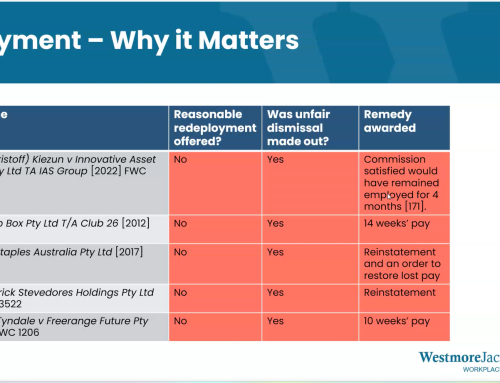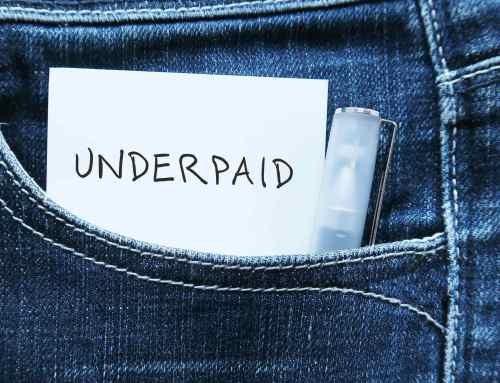
The Pitfalls of JobKeeper and COVID-19 Work Practices
The JobKeeper scheme is an ambitious lifeline to employers, codified in legislation less than two weeks after its initial announcement.
However, the scheme’s fine print and changing work practices due to COVID-19 may create unforeseen complications for employers. This article considers 4 such examples.
- Employees may refuse to return to the workplace
As the curve continues to flatten, some employees might refuse to return to in-person work. They may have realised the benefits of working from home or express concerns for their safety or the safety of their household.
Whether an employer can insist that an employee return to work depends on the particular circumstances.
Broadly, employers have a general right to direct employees to return to the workplace after working from home if the direction is lawful and reasonable.
For employees whose work must be completed in-person, such as hairdressers and surgeons, returning to work is a necessary step to reopen the business. But for employees who can and have been working from home, the point at which the employer can require them to return to work is less clear.
Generally, it will only be reasonable to return to the workplace if an employer has sufficiently eliminated or controlled any health risks in line with applicable safety legislation. Employers also have a duty to consult with employees and any safety representatives on matters related to health or safety that directly affect them.
It is preferable that employers develop a “COVIDSafe Plan” before asking employees to return to work. This involves checking off the workplace’s compliance with relevant government directives, the National COVID-19 Safe Workplace Principles and other workplace safety guidelines. With a COVIDSafe Plan in place, a direction to return to work is more likely to be reasonable.
Whether a direction is reasonable may also involve an assessment of the employees’ individual circumstances, such as their health or the health of someone they live with.
Some employees might still express concerns about returning to the workplace despite all the necessary precautions being put in place. If the employee refuses a lawful and reasonable direction to return to the office, this may constitute a valid reason for dismissal, notwithstanding the employee’s concerns. In Steffen Haun v G4S Health Services Australia Pty Ltd
- JobKeeper Enabling Direction (“JED”) requirements
Under the JobKeeper scheme legislation, employers can give certain directions to JobKeeper employees. These directions include reducing hours, changing work duties and altering work locations. However, employers should be aware of the compliance requirements associated with making these directions.
Consultation and reasonableness
Employers must give written notice to employees of the potential JED and consult with them before issuing the direction. In addition, directions will not apply if they are “unreasonable in all the circumstances”.
When considering the reasonableness of a direction, employers should weigh a JED against the employee’s personal circumstances. This includes any caring responsibilities the employee may have. Employers should also ensure that a meaningful consultation process is undertaken before giving the direction.
Employee requests for training or professional development
The JobKeeper scheme also inserts a new employee workplace right into the Fair Work Act 2009 (Cth). Employees who have been given a JobKeeper enabling stand down direction may request to undertake training or professional development. The employer must consider any request and cannot unreasonably refuse.
This means that employers using the JobKeeper subsidy to keep workers employed may, in some circumstances, have to shoulder the additional expense of paying for training or professional development in an already difficult period. However, it is likely that an employee request for training or professional development which incurs significant or unrealistic costs to the business could be lawfully refused.
- Nominating casuals
Casuals “employed… on a regular and systematic basis” (“long term casuals”) for at least 12 months as at 1 March 2020 are eligible for nomination as JobKeepers. The ‘one-in, all in’ rule obliges employers to nominate all eligible employees, including long-term casuals.
The risks of nominating casuals are twofold:
- first, there is the risk that nomination could be evidence that a “casual” is really a permanent employee; and
- second, if a casual is truly a casual employee, they have no obligation to accept work, and cannot be forced to comply with JEDs.
On the first point, employers may be wary that acknowledging regular and systematic employment of a casual could be considered evidence of a mutual ongoing obligation of employment. This could breach the essence of casual employment, which is the absence of a firm advance commitment between the employer and employee for the employee to work particular hours, days, or at all (Workpac Pty Ltd v Skene [2018] FCAFC 131 [153]). On its own, nomination is unlikely to be indicative of a permanent relationship, but when considered with other evidence, this could leave open the door to a successful claim for permanent employee entitlements, such as annual leave.
The second issue is whether JEDs are enforceable against JobKeeper causals. Casuals have no obligation to accept shifts, let alone in new locations or with different duties as the JED provisions set out. Some casual employees might refuse to work shifts and still be paid the JobKeeper subsidy. This is an unintended consequence of the scheme which may hurt employers.
- Increasing employee hours to reach the $1,500 per fortnight threshold
Some part-time and casual employees whose income is normally less than $1,500 per fortnight are now eligible for that full amount through the JobKeeper scheme. Some employers have reportedly tried to take advantage of this by telling employees that JobKeeper nomination is conditional on the employees agreeing to work extra hours to bring their remuneration up to $1,500 per fortnight.
This is problematic. The ‘one in, all in’ feature of the scheme means that all eligible employees must be nominated without further conditions.
Employers seeking to increase hours or days of work must comply with the usual requirements under the Fair Work Act 2009 (Cth). Any additional hours must be requested and be reasonable. If the only reason for a request to work additional hours is to match the amount of the JobKeeper payment, this is not likely to be reasonable.
When making a request to increase hours, employers should ensure there is a good reason to do so, other than to simply match JobKeeper payments.
Conclusion
The JobKeeper scheme and surrounding circumstances of COVID-19 are creating some unexpected situations for employers. But with the right advice, employers can use both new and existing mechanisms to get their employees back to work and their business back on track.
Adam Colquhoun, Principal
This article is general information only. It is not legal advice. If you need legal advice, please contact us.





